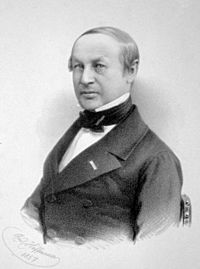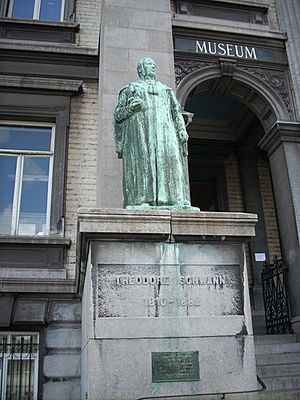Theodor Schwann facts for kids
Quick facts for kids
Theodor Schwann
|
|
|---|---|

Schwann in 1857
|
|
| Born | 7 December 1810 |
| Died | 11 January 1882 (aged 71) |
| Education | |
| Known for |
|
| Awards | Copley Medal (1845) |
| Scientific career | |
| Fields | Biology |
| Influences | Johannes Peter Müller |
Theodor Schwann (7 December 1810 – 11 January 1882) was a German doctor and scientist who studied how living things work (a physiologist). His most important discovery in biology was showing that cell theory applies to animals, not just plants.
He also discovered special cells in the nervous system called Schwann cells. He found and studied an important digestive chemical called pepsin. Schwann also showed that yeast is a living organism and created the word "metabolism" to describe how living things use energy.
Contents
Early Life and Education
Theodor Schwann was born in Neuss on December 7, 1810. His father, Leonard Schwann, was a goldsmith and later a printer. Theodor went to a Jesuit school in Cologne. He was a very religious Roman Catholic.
In 1829, Schwann started studying medicine at the University of Bonn. He earned a degree in philosophy in 1831. While at Bonn, he met and worked with a famous physiologist named Johannes Peter Müller. Müller is known for starting scientific medicine in Germany.
In 1831, Schwann moved to the University of Würzburg for medical training. Then, in 1833, he went to the University of Berlin. Müller was now a professor there. Schwann earned his medical degree in 1834. For his final project, he studied how chicken embryos need oxygen to grow. He even built a special machine to control the gases. This helped him figure out when eggs needed oxygen the most.
After graduating, Schwann chose to keep working with Müller on research instead of becoming a practicing doctor.
Schwann's Scientific Career
From 1834 to 1839, Schwann worked as Müller's assistant at the University of Berlin. He did many experiments using microscopes. He studied the structure and function of nerves, muscles, and blood vessels. Many of his key discoveries happened during this time.
Schwann used powerful new microscopes to look closely at animal tissues. He saw animal cells and noticed their different features. His work went well with the discoveries of his friend, Matthias Jakob Schleiden, who studied plant cells.
People described Schwann as quiet and serious. He was very good at building and using equipment for his experiments. He was also skilled at finding important scientific questions and designing tests to answer them. His writings were easy to understand, and his thinking was very clear.
By 1838, Schwann needed a better-paying job. In 1839, he became a professor of anatomy at the Université Catholique de Louvain in Belgium.
Schwann was a dedicated teacher. With his new teaching duties, he had less time for new scientific work. He focused on making his experimental methods and tools better. One important paper he wrote in 1844 showed how bile is important for digestion in dogs.
Schwann wanted to show that living processes, like muscle movement or digestion, were caused by physical things, not some magical "life force." However, he still believed that nature followed a "divine plan."
In 1848, Schwann moved to the University of Liège, also in Belgium. He kept up with new ideas in anatomy and physiology but didn't make many big new discoveries himself. He became an inventor. One of his inventions was a portable breathing device, like a very early respirator.
Schwann retired in 1879. He was highly respected by other scientists. In 1878, a celebration was held for him. He received a book with 263 signed photos of scientists from around the world. The book was dedicated "To the creator of the cell theory."
Schwann died in Cologne on January 11, 1882. He was buried in his family's tomb.
Key Discoveries
Schwann's research was a careful and organized effort to explain how living things work. He described biological processes using physical objects and the forces they create. His idea that the cell is a basic, active unit helped create the field of microbiology.
Muscle Tissue
One of Schwann's first studies in 1835 was about muscle contraction. He wanted to find a way to measure the force of muscle contractions. He created a method to calculate this force by controlling other factors. His measurement techniques were later used by other scientists. Schwann hoped to find rules and laws that explained how the body works.
Pepsin and Digestion
In 1835, scientists didn't know much about how digestion worked. Schwann realized that other substances in digestive juices might help break down food.
In 1836, Schwann began studying digestion. He thought that digestion was caused by a special substance, even if it couldn't be seen easily. He found an enzyme called pepsin and successfully separated it from the stomach lining. He named it "pepsin" from the Greek word pepsis, meaning "digestion."
Pepsin was the first enzyme ever found in animal tissue. Schwann showed that pepsin could break down the albumin (protein) from egg whites into smaller parts called peptones. He believed that by studying such processes, scientists could eventually "explain the whole developmental process of life."
Yeast and Fermentation
Next, Schwann studied yeast and fermentation. His work on yeast was done at the same time as other scientists, and they all published their findings in 1837.
By 1836, Schwann had done many experiments on how alcohol is made through fermentation. Powerful microscopes allowed him to see yeast cells in detail. He realized they were tiny living organisms, similar to plants.
Schwann was the first to say that yeast was the main cause of fermentation and that it was alive. He used his microscope to do careful experiments. He showed that if he heated the liquid from fermenting beer, it could no longer ferment. This suggested that something living was needed for the process.
He also tested the effects of clean air versus unclean air. He sterilized the air by heating it. Fermentation did not happen with the clean air, but it did with the unclean air. This was strong evidence against the idea of spontaneous generation, which was the belief that living things could just appear from non-living matter.
Schwann showed that fermentation needed yeast to start and stopped when the yeast stopped growing. He concluded that sugar turned into alcohol because of a living process involving yeast. He proved that fermentation was not just a simple chemical reaction.
Many scientists at the time, like Justus von Liebig, disagreed with Schwann. They thought fermentation was purely chemical and didn't involve living things. However, Schwann's work was later seen as a step away from the idea of "vitalism" (that life has a special, non-physical force).
Years later, Louis Pasteur confirmed Schwann's work on fermentation. Pasteur accepted that yeast were alive and continued the research. Schwann's influence can be seen in Pasteur's germ theory and Lister's use of antiseptics.
Cell Theory
In 1837, Matthias Jakob Schleiden observed that new plant cells grew from the centers (nuclei) of older plant cells. One day, while having dinner with Schwann, they talked about the nuclei of plant and animal cells. Schwann remembered seeing similar structures in animal cells. He immediately realized how important this connection was.
Schwann then did more experiments. He looked at tissues from toad larvae and pig embryos. He confirmed that animal tissues are also made of cells, and each cell has a nucleus.
Schwann published his findings in 1838. Then, in 1839, he published his famous book, Microscopic Investigations on the Similarity of Structure and Growth of Animals and Plants. This book is considered a very important work in modern biology.
In his book, Schwann stated that "All living things are made of cells and cell products." He also made three main points about cells, which became his cell theory:
- The cell is the basic unit of structure, function, and organization in living things.
- A cell exists as a separate unit, but it also works as a building block in larger organisms.
By the 1860s, these two ideas were widely accepted as the foundation of cell theory. Schwann believed that "there is one universal principle of development for the elementary parts of organisms." He supported this by looking at adult animal tissues and grouping them into five types of cell-based tissues:
- Independent and separate cells, like blood cells.
- Independent cells packed together in layers, like skin or fingernails.
- Cells whose connecting walls have joined, like cartilage or bones.
- Long cells that form fibers, like tendons.
- Cells formed by the joining of walls and spaces, like muscles and nerves.
His observation that a single-celled ovum (egg) grows into a complete organism also helped establish a basic idea in embryology (the study of how living things develop).
Schwann's third idea about how cells formed was later proven wrong. He thought that living cells formed in a similar way to crystals. However, scientists later accepted the idea from Rudolf Virchow: Omnis cellula e cellula—meaning "Every cell comes from another cell."
Specialized Cells
Schwann was especially interested in nervous and muscular tissues. While classifying body tissues, he discovered the cells that wrap around nerve fibers. These cells are now called Schwann cells in his honor.
Schwann also found that muscle tissue in the upper part of the esophagus (the tube that carries food to the stomach) was striated (striped). He thought that this muscular structure helped the esophagus move food.
When looking at teeth, Schwann was the first to notice "cylindrical cells" connected to the inner surface of the enamel and the pulp. He also found tiny fibers in the tooth tubes.
Metabolism
In his book Microscopical researches, Schwann introduced the word "metabolism." He first used it in German to describe the chemical actions happening inside cells. The term "metabolism" was later used in English in 1878 by Michael Foster.
See also
 In Spanish: Theodor Schwann para niños
In Spanish: Theodor Schwann para niños


